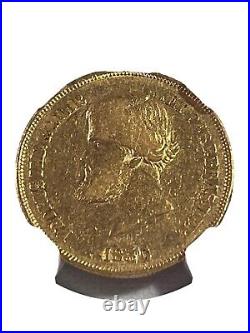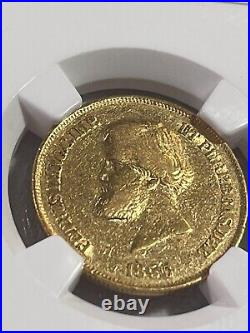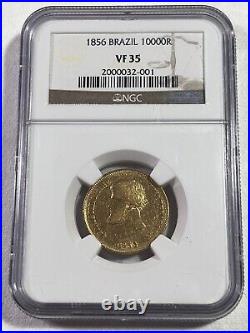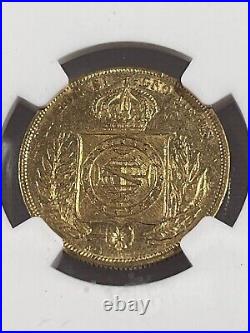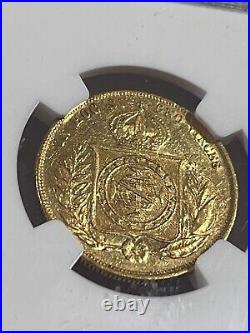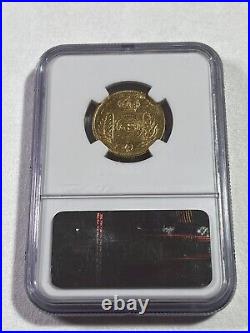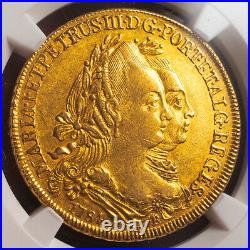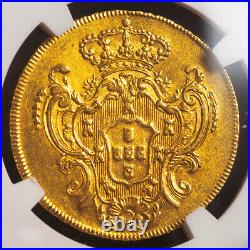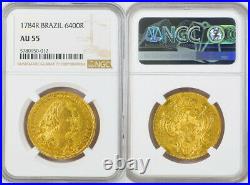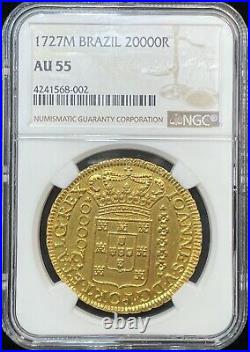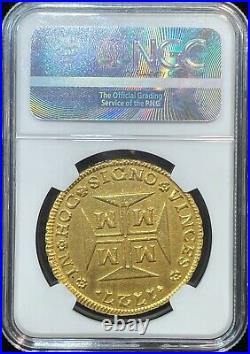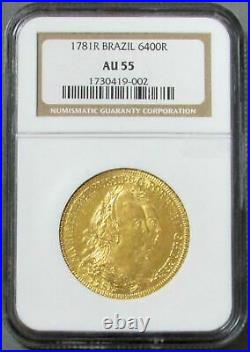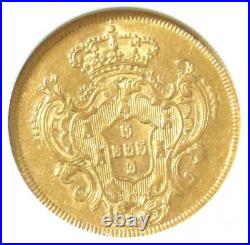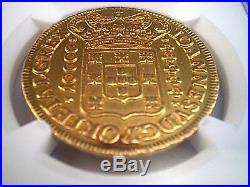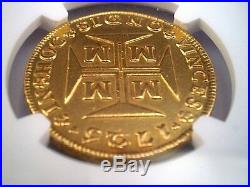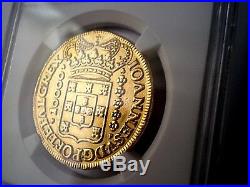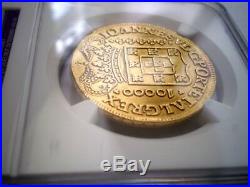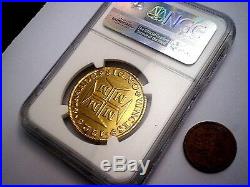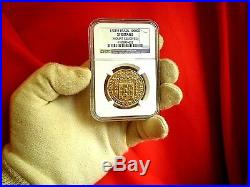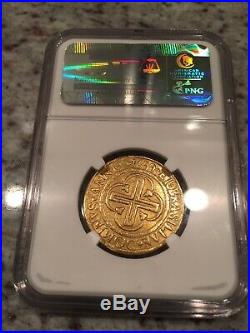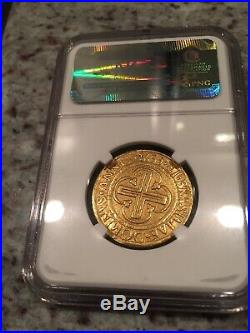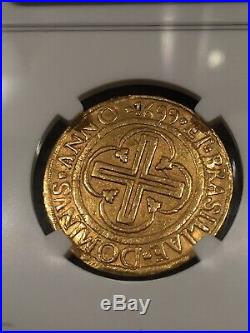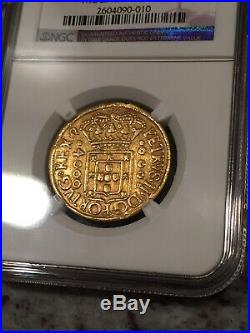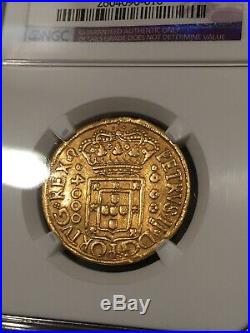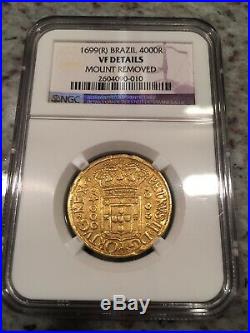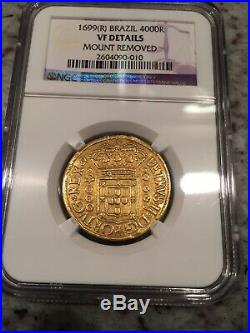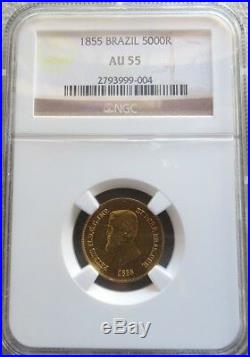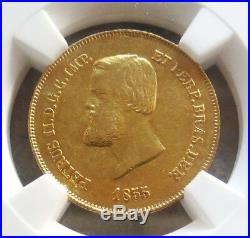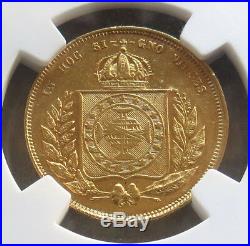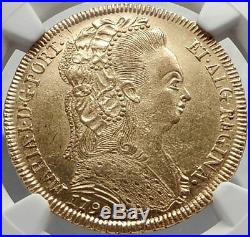
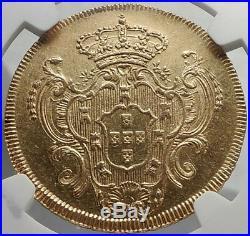
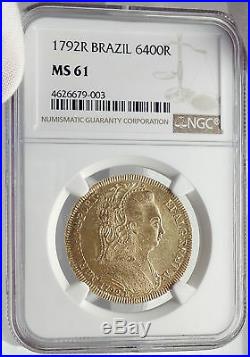
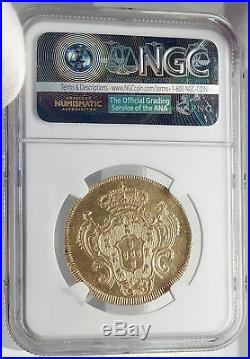
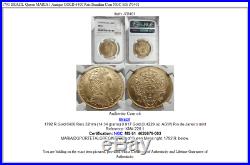

Item: i70401 Authentic Coin of. 1792 R Gold 6400. Reis 32mm (14.34 grams) 0.917 Gold 0.4229 oz. AGW Rio de Janeiro mint Reference: KM# 226.1. Bust of Queen Maria right; 1792. All coins of Brazil. Available for sale in my store. Dona Maria I (English: Mary I ; 17 December 1734 – 20 March 1816) was Queen of Portugal, Brazil, and the Algarves. Known as Maria the Pious (in Portugal), or Maria the Mad (in Brazil), she was the first undisputed Queen regnant of Portugal and the first monarch of Brazil. With Napoleon’s European conquests, her court, then under the direction of Prince Dom João, the Prince Regent, moved to Brazil, then a Portuguese colony. Later on, Brazil would be elevated from the rank of a colony to that of a kingdom, with the consequential formation of the United Kingdom of Portugal, Brazil and the Algarves. Maria was born at the Ribeira Palace in Lisbon and baptized Maria Francisca Isabel Josefa Antónia Gertrudes Rita Joana. On the day of her birth, her grandfather, King John V of Portugal, created her the Princess of Beira. When her father succeeded to the throne in 1750 as Joseph I, Maria, at age 16 and as his eldest child, became his heiress presumptive and was given the traditional titles of Princess of Brazil and Duchess of Braganza. Influence of the Marquis of Pombal. Maria grew up in a time when her father’s government was dominated completely by the first Marquis of Pombal. Her father would often retire to the Palace of Queluz which was later given to Maria and her husband. The Marquis took control of the government after the terrible 1755 Lisbon earthquake of 1 November 1755, in which around 100,000 people lost their lives. The palace of her birth was also destroyed in the disaster. After the earthquake, Maria’s father was often uncomfortable at the thought of staying in enclosed spaces, and later suffered from claustrophobia. The king had a palace built in Ajuda, away from the city centre. This palace became known as Real Barraca de Ajuda (Royal Hut at Ajuda) because it was made of wood. The family spent much time at the large palace, and it was the birthplace of Maria’s first child. In 1794 the palace burned to the ground and the Palace of Ajuda was built in its place. In 1760 Maria married her uncle Pedro, younger brother of her father Jose I. They had six children, of whom the eldest surviving son succeeded Maria as João VI on her death in 1816. In 1777, Maria became the first undisputed queen regnant of Portugal and the Algarves. With Maria’s accession, her husband became king as Peter III. Despite Peter’s status as king and the nominal joint reign, the actual regal authority was vested solely in Maria. As she was the lineal heir of the crown. Also, as Peter’s kingship was iure uxoris only, his reign would cease in the event of Maria’s death, and the crown would pass to Maria’s descendants. However, Peter predeceased his wife. Maria is considered as having been a good ruler in the period prior to her madness. Her first act as queen was to dismiss the popular Secretary of State of the kingdom, the Marquess of Pombal, who had broken the power of the reactionary aristocracy via the Távora affair, partially because of Pombal’s Enlightenment, anti-Jesuit policies. Noteworthy events of this period include Portugal’s membership in the League of Armed Neutrality (July 1782) and the 1781 cession of Delagoa Bay from Austria to Portugal. Queen Maria suffered from religious mania and melancholia. Maria’s madness was first officially noticed in 1786, when Maria had to be carried back to her apartments in a state of delirium. Afterward, the queen’s mental state became increasingly worse. In May 1786, her husband died; Maria was devastated and forbade any court entertainments. According to a contemporary, state festivities began to resemble religious ceremonies. Her condition worsened after the death of her eldest son (and heir-apparent), aged 27, from smallpox, and of her confessor, in 1791. In February 1792, she was deemed mentally insane and was treated by Francis Willis, the same physician who attended King George III of Great Britain. Willis wanted to take her to England, but the plan was refused by the Portuguese court. Maria’s second son (eldest surviving) and new heir-apparent, John, took over the government in her name, even though he only took the title of Prince Regent in 1799. When the Real Barraca de Ajuda burnt down in 1794, the court was forced to move to Queluz, where the ill queen would lie in her apartments all day. Visitors would complain of terrible screams that would echo throughout the palace. In 1801 Spanish Prime Minister Manuel de Godoy sent an army to invade Portugal with backing from Napoleon, resulting in the War of the Oranges. Though the Spanish ended their invasion, the Treaty of Badajoz on 6 June 1801 forced Portugal to cede Olivença and other border towns to Spain. This cession is not recognized by the present Portuguese government, and the country officially considers those territories still to be Portuguese possessions. On September 29, 1801 John VI signed the Treaty of Madrid (1801), ceding half of Guyana to France, which became French Guiana. The refusal of the Portuguese government to join the French-sponsored Continental Blockade against Britain culminated in the late 1807 Franco-Spanish invasion of Portugal led by General Junot. The ultimate Napoleonic plan for Portugal was to split it into three sections. The northern parts of Portugal, from the Douro to the Minho, would become the Kingdom of Northern Lusitania, and its throne was promised to King Carlo Lodovico II of Etruria. The Alentejo Province and Kingdom of the Algarve would be merged to form the Principality of the Algarves , of which Spanish Prime Minister Manuel de Godoy would be sovereign. The remaining portion of Portugal would have been directly ruled by France. At the urging of the British government, the entire Braganza Dynasty decided to flee on 29 November 1807 to establish a government in exile in the Portuguese Viceroyalty of Brazil. Along with the royal family, Maria was transported aboard the carrack Príncipe Real. During her move from the royal palace to the docks she was heard screaming throughout the trip, in the middle of the crowd and in the carriage. The queen’s dementia was so great that she feared that she was going to be tortured or robbed during her movement by her servants. In January 1808 Prince Regent João and his court arrived in Salvador da Bahia. Under pressure by local aristocracy and the British, the prince regent signed a commercial regulation after his arrival that opened commerce between Brazil and friendly nations, which in this case represented the interests of Great Britain above all. This law broke an important colonial pact that had previously allowed Brazil to maintain direct commercial relations only with Portugal. On 1 August 1808 British General Arthur Wellesley (later Duke of Wellington) landed a British army in Lisbon to initiate the Peninsular War. The impact of Wellesley’s initial victory over Junot at the Battle of Vimeiro (21 August 1808) was wiped out by his superiors in the Convention of Cintra (30 August 1808), which allowed the defeated French troops to evacuate peacefully from Portugal. In 1815 the government of the Prince Regent João elevated Brazil to the status of a kingdom, and Maria I was proclaimed the Queen of the United Kingdom of Portugal, Brazil and the Algarves. When Napoleon was finally defeated in 1815, Maria and her family remained in Brazil. Maria lived in Brazil for a total of eight years, always in a state of incapacitation. In 1816, she died at the Carmo Convent in Rio de Janeiro at the age of 81. Maria is a greatly admired figure in both Brazil and Portugal due to the tremendous changes and events that took place during her reign. In Portugal, she is celebrated as a strong female figure. Her legacy shines at Portugal’s Queluz Palace, a baroque-roccoco masterpiece that she helped conceive. A large statue of her stands in front of the palace, and a pousada near the palace is named in her honour. A large marble statue of the queen was erected at the Portuguese National Library in Lisbon by the students of Joaquim Machado de Castro. In Brazil, she is admired as a key figure in the eventual independence of Brazil. It was during her reign, albeit through the government of her son’s regency, that many of the national institutions and organizations in Brazil were created. These institutions were the precursors to their modern-day equivalents and granted large degree of power to the Brazilian colonials. While she is often called A Louca (the Mad) in Brazil, Brazilian and Portuguese historians hold her in high esteem. Brazil , officially the Federative Republic of Brazil , is the largest country in both South America and Latin America. As the world’s fifth-largest country by both area and population, it is the largest country to have Portuguese as an official language-and the only one in the Americas. Bounded by the Atlantic Ocean on the east, Brazil has a coastline of 7,491 km (4,655 mi). It borders all other South American countries except Ecuador and Chile and covers 47.3% of the continent’s land area. Its Amazon River basin includes a vast tropical forest, home to diverse wildlife, a variety of ecological systems, and extensive natural resources spanning numerous protected habitats. This unique environmental heritage makes Brazil one of 17 megadiverse countries, and is the subject of significant global interest and debate regarding deforestation and environmental protection. Brazil was inhabited by numerous tribal nations prior to the landing in 1500 of explorer Pedro Álvares Cabral, who claimed the area for the Portuguese Empire. Brazil remained a Portuguese colony until 1808, when the capital of the empire was transferred from Lisbon to Rio de Janeiro. In 1815, the colony was elevated to the rank of kingdom upon the formation of the United Kingdom of Portugal, Brazil and the Algarves. Independence was achieved in 1822 with the creation of the Empire of Brazil, a unitary state governed under a constitutional monarchy and a parliamentary system. The ratification of the first constitution in 1824 led to the formation of a bicameral legislature, now called the National Congress. The country became a presidential republic in 1889 following a military coup d’état. An authoritarian military junta came to power in 1964 and ruled until 1985, after which civilian governance resumed. Brazil’s current constitution, formulated in 1988, defines it as a democratic federal republic. The federation is composed of the union of the Federal District, the 26 states, and the 5,570 municipalities. Brazil’s economy is the world’s ninth-largest by nominal GDP and seventh-largest by GDP (PPP) as of 2015. A member of the BRICS group, Brazil until 2010 had one of the world’s fastest growing major economies, with its economic reforms giving the country new international recognition and influence. Brazil’s national development bank plays an important role for the country’s economic growth. Brazil is a founding member of the United Nations, the G20, BRICS, Unasul, Mercosul, Organization of American States, Organization of Ibero-American States, CPLP, and the Latin Union. Brazil is a regional power in Latin America and a middle power in international affairs, with some analysts identifying it as an emerging global power. One of the world’s major breadbaskets, Brazil has been the largest producer of coffee for the last 150 years. World-renowned expert numismatist, enthusiast, author and dealer in authentic ancient Greek, ancient Roman, ancient Byzantine, world coins & more. Ilya Zlobin is an independent individual who has a passion for coin collecting, research and understanding the importance of the historical context and significance all coins and objects represent. Send me a message about this and I can update your invoice should you want this method. Getting your order to you, quickly and securely is a top priority and is taken seriously here. Great care is taken in packaging and mailing every item securely and quickly. What is a certificate of authenticity and what guarantees do you give that the item is authentic? You will be very happy with what you get with the COA; a professional presentation of the coin, with all of the relevant information and a picture of the coin you saw in the listing. Additionally, the coin is inside it’s own protective coin flip (holder), with a 2×2 inch description of the coin matching the individual number on the COA. Whether your goal is to collect or give the item as a gift, coins presented like this could be more prized and valued higher than items that were not given such care and attention to. When should I leave feedback? Please don’t leave any negative feedbacks, as it happens sometimes that people rush to leave feedback before letting sufficient time for their order to arrive. The matter of fact is that any issues can be resolved, as reputation is most important to me. My goal is to provide superior products and quality of service. How and where do I learn more about collecting ancient coins? Visit the Guide on How to Use My Store. For on an overview about using my store, with additional information and links to all other parts of my store which may include educational information on topics you are looking for. The item “1791 BRAZIL Queen MARIA I Antique GOLD 6400 Reis Brazilian Coin NGC MS i70401″ is in sale since Tuesday, June 19, 2018. This item is in the category “Coins & Paper Money\Coins\ World\South America\Brazil”. The seller is “highrating_lowprice” and is located in Rego Park, New York. This item can be shipped worldwide.
- Country/Region of Manufacture: Brazil
- Certification Number: Uncirculated
- Certification: NGC
- Grade: MS 61
- Year: 1792
- Circulated/Uncirculated: Uncirculated
- Composition: Gold

